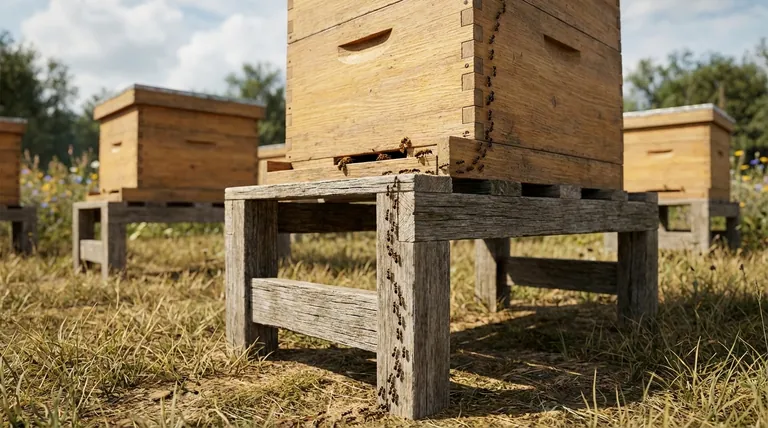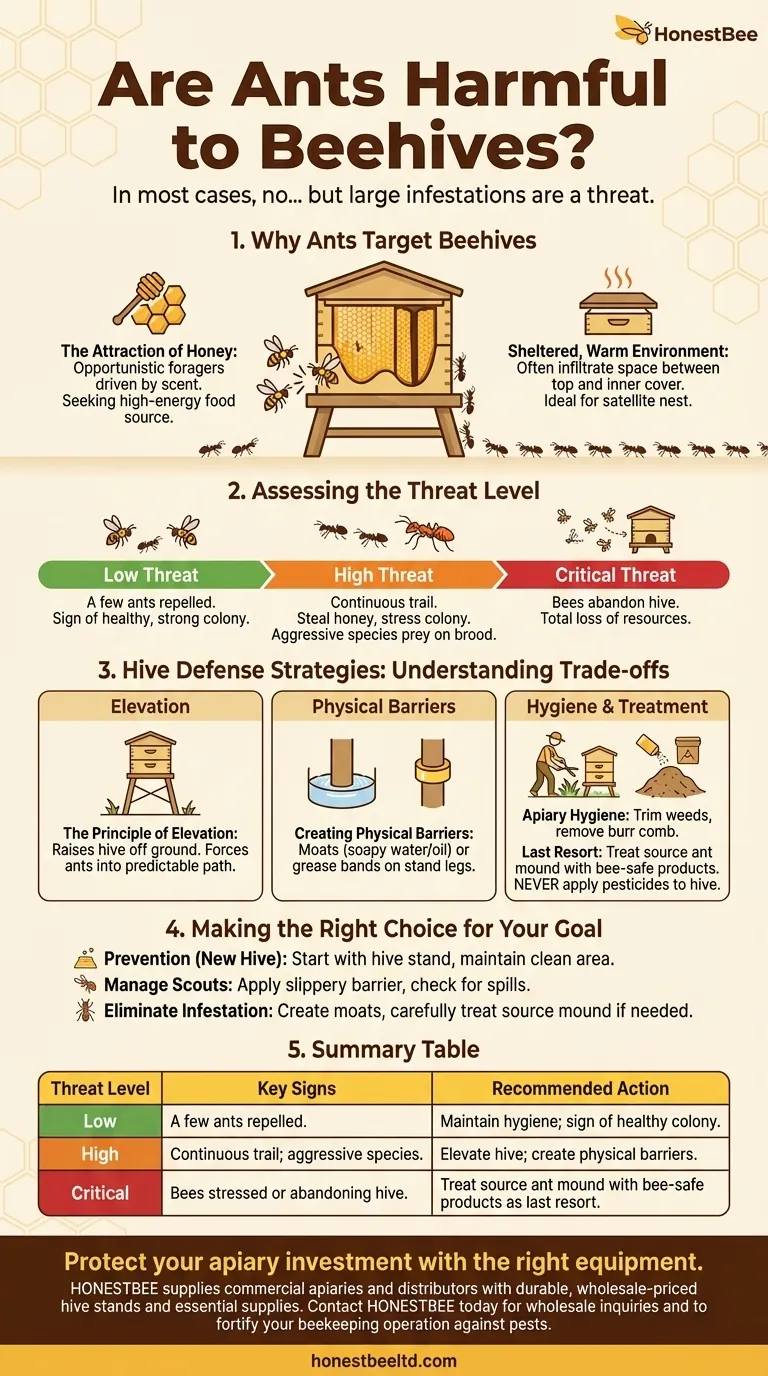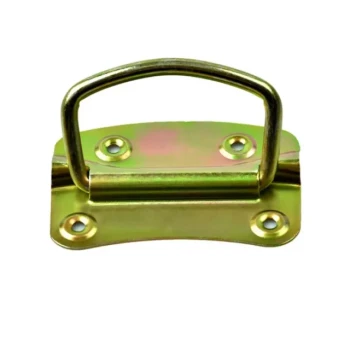In most cases, a few ants are not a threat to a beehive. A healthy, populous colony has dedicated guard bees that can easily defend against small numbers of foraging ants. However, a large-scale infestation, particularly by aggressive species like Argentine or fire ants, can weaken a colony, steal significant resources, prey on developing bees, and even cause the entire colony to abandon the hive.
The presence of ants is not an attack on your bees, but a symptom of opportunity. Your goal is not to eliminate every ant, but to make your hive an unattractive and inaccessible target for them.

Why Ants Target Beehives
The Attraction of Honey
Ants are opportunistic foragers driven by scent. The sweet aroma of honey and beeswax is an irresistible signal that a high-energy food source is nearby. They are not seeking to fight bees, but to access this valuable resource.
A Sheltered, Warm Environment
Ants often infiltrate the space between the top cover and inner cover of a hive. This area is dark, protected from the elements, and warmed by the heat of the bee cluster, making it an ideal place for ants to establish a satellite nest close to their food source.
Assessing the Threat Level: When to Worry
The Sign of a Healthy Hive
Seeing a few ants being repelled from the hive entrance is often a positive sign. It indicates your colony is strong, alert, and has a sufficient population of guard bees to manage minor intrusions effectively.
The Tipping Point: Large Infestations
The real danger comes from overwhelming numbers. A continuous trail of ants entering the hive signals a major problem. They will steal honey, stress the colony, and can eventually cause the bees to abscond, meaning they abandon the hive and its resources entirely.
The Species to Watch: Aggressive Invaders
Not all ants are equal. Omnivorous species, such as Argentine ants and fire ants, pose a much greater threat. They will not only steal honey but will actively prey on bee larvae and pupae (the brood), directly reducing the colony's future population. These species have also been known to carry and potentially transmit harmful pathogens like the deformed wing virus.
Understanding the Trade-offs: Hive Defense Strategies
The Principle of Elevation
The single most effective preventative measure is raising your hive off the ground with a hive stand. This makes access more difficult for ants and other pests like skunks and mice. It forces any invading ants into a predictable, vertical path that is easier to defend.
Creating Physical Barriers
Once the hive is elevated, you can fortify the legs of the stand. Applying a thick, slippery band of Vaseline or automotive grease can create a barrier ants cannot cross, though it requires reapplication after rain. A more durable option is to place each leg of the stand inside a small container of soapy water or oil, creating a moat that drowns any ants attempting to cross.
The Importance of Apiary Hygiene
Do not create an inviting environment for pests. Regularly trim grass and weeds around the hive that could form a bridge for ants. Promptly remove any burr comb or dropped pieces of honeycomb, and ensure your hive boxes are in good repair with no cracks or holes that offer easy entry points.
The Last Resort: Treating the Source
If you can locate the source ant mound, treating it directly can solve the problem. However, this carries risk. Never apply pesticides or insecticides on the beehive itself. Use bee-safe or natural products on the mound, and apply them carefully to prevent drift that could harm your bees. This should only be considered after physical barriers have proven insufficient.
Making the Right Choice for Your Goal
- If your primary focus is prevention for a new hive: Start with a hive stand from day one and maintain a clean, weed-free area around it.
- If your primary focus is managing a few scout ants: Apply a slippery barrier like Vaseline to the hive stand legs and double-check your apiary for any spilled honey or discarded comb.
- If your primary focus is eliminating a large infestation: Create a moat for each leg of your hive stand and, if the pressure continues, locate and carefully treat the source ant mound.
Proactive management and a well-defended hive are the keys to ensuring ants remain a minor nuisance rather than a genuine threat.
Summary Table:
| Threat Level | Key Signs | Recommended Action |
|---|---|---|
| Low | A few ants being repelled by guard bees. | Maintain hive hygiene; a sign of a healthy colony. |
| High | Continuous trail of ants; aggressive species present. | Elevate hive; create physical barriers (e.g., moats, grease). |
| Critical | Bees are stressed or abandoning the hive. | Treat source ant mound with bee-safe products as a last resort. |
Protect your apiary investment with the right equipment. A strong defense starts with a sturdy foundation. HONESTBEE supplies commercial apiaries and beekeeping equipment distributors with durable, wholesale-priced hive stands and essential supplies to help you implement these preventative measures effectively. Contact HONESTBEE today for wholesale inquiries and to fortify your beekeeping operation against pests.
Visual Guide

Related Products
- Wholesales Dadant Size Wooden Bee Hives for Beekeeping
- Black Plastic Beetle Barn Hive Beetle Trap for Beehives
- Removable Washable Hive Beetle Trap Attractants for Small Hive Beetles
- Professional Multi-Function Stainless Steel Hive Tool
- Long Langstroth Style Horizontal Top Bar Hive for Wholesale
People Also Ask
- What types of products are available for beekeeping needs? Essential Equipment for Apiaries & Distributors
- What is the best place to keep bees? Find the Perfect Apiary Site for Your Hives
- What are the characteristics of oil-based paint for beehives? Durability vs. Modern Practicality
- What should you do if you find an ant nest near your beehive? Essential Strategies for Hive Protection
- How often should the area under beehives be inspected and cleaned during the warm season? A Proactive Maintenance Guide



















